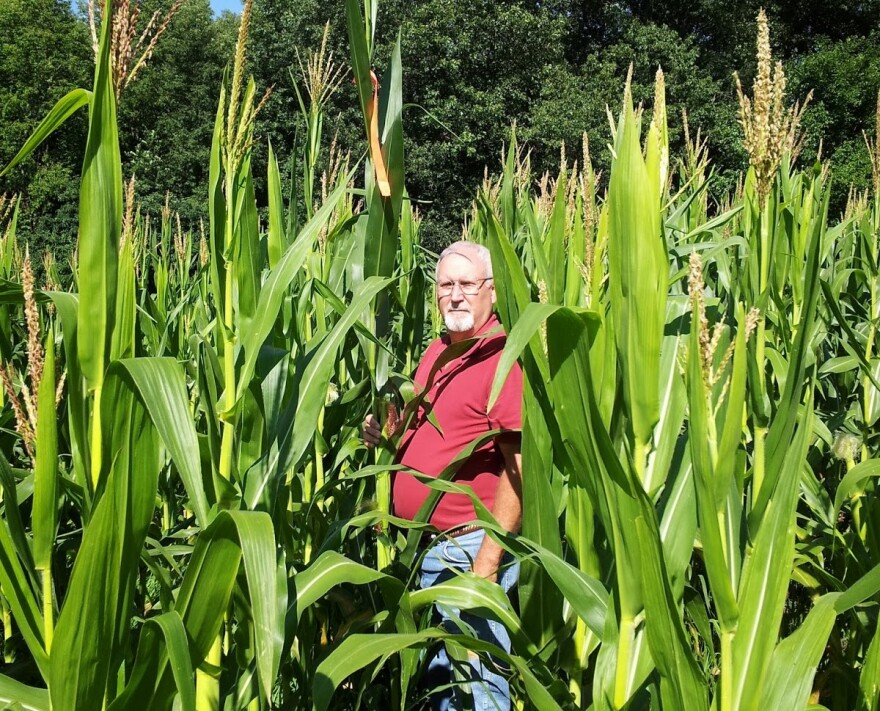Michigan corn can be a tricky business. Parts of Southwest Michigan are considered the seed corn capital of the United States. But problems like drought and falling grain prices in recent years have left farmers scrambling to just make a profit. One Kalamazoo entrepreneur, however, is pushing beyond genetically modified food to fix the problem, and instead is looking to the past.
With his deep Southern drawl, checkered shirt and Colonel Sanders facial hair, James Friedrich just looks like he belongs in the middle of a corn field. Unfortunately, this morning, he and his assistant, Scott, are stuck inside their bare, concrete office as the snow melts outside. The only way you’d know this was a real business is a tiny sheet taped to the door with the company’s name: “Native Traits”. You’d never guess this was the home of a company that had just received $500,000 in investor funding.
The two are prepping for the spring harvest, counting seeds and bagging them to send out to test plots across the Midwest.
"So what you see Scott here doing is kind of counting the seed that will be counted out to go to Iowa and Illinois and elsewhere over the coming months," Friedrich explains over the drop of each kernel.
These aren’t just any seeds, Friedrich says. They’re the descendants of ancient corn, used by farmers back in the early 1900s, before the dawn of modern agriculture. And if everything goes right, he says, they could soon make a comeback. For Friedrich, the journey to these seeds started decades ago, when he sat down with elderly farmers. They would share secrets about certain kinds of corn that were special.
"And what you find is that for these older strains of corn, the best information is anecdotal," Friedrich explains. "When I talked to these older corn breeders, they knew of sources for this trait or that trait."
In particular, Friedrich heard stories of a few varieties that survived in colder months, like March and April. That’s huge for corn – if a crop can survive the colder temperatures, a farmer is suddenly looking at an extra month or two of production.
So Friedrich took those varieties and searched for them on the website of the U.S. Department of Agriculture’s seed bank -- basically a huge repository of hundreds of thousands of old seeds. So what did Friedrich search for to find an exciting seed?
"Well that's the sort of thing that we keep secret," Friedrich says. "But anybody who wants to is welcome to go scrolling through 20,000 different strains of corn online, and you will find some very interesting names. And some of them are true! What you find about them is true."
The good thing about the seed bank is that it’s like a library. It shares. If you want to plant a specific seed, just make a request, and they’ll send you some kernels. That’s what Friedrich did.
But there was still a challenge: the seeds needed to resist cold like the old, ancient varieties, but still produce enough corn to compete with advanced new seeds. To do that, Friedrich planted new and old seeds next to each other and let them mix naturally.
"That's how you do it," Friedrich says. "Just letting Mother Nature do it."
At first it was just a little experiment. But then, drought struck the Midwest in 2012. And when Friedrich reviewed his data, the cold-tolerant corn performed far better than the normal varieties. Suddenly, his seed was marketable. Native Traits was born.
Searching for seeds this way -- by pouring through thousands and thousands of old records to find a seed that could maybe work, is laborious. But with the way agriculture could be changing in the United States, it might be worth it.
Roughly 90 percent of corn produced in the U-S is genetically engineered, and for good reason. It’s can lead to more production, and it can protect against bugs and weeds. But over the past few years, corn prices have plummeted. That’s made the cheaper, non-genetically engineered corn -- like Native Traits -- more appealing for smaller farms.
"We saw a market, and we knew there was a potential," Friedrich says. "Nobody was really doing it. The big companies are very caught up in GMO and genetic engineering and this was something we could do to get a product that the farmers could value"
But the other big factor here is that more and more people are searching out organic, natural food. That’s forcing companies to re-evaluate their ingredients.
"We are certainly seeing that in some areas," says Steve Pueppke, a researcher at Michigan State University. "And cereals come to mind, where there have been a couple of recent announcements that cereals, certain brands in the future will not have GMO ingredients. We can be pretty sure that those are being marketed in response to customer concerns."
"And it's not just the GMO issue," he says. "They're going to have more demands, more questions, more interest in where it came from."
With the sudden interest, that gives consumers more options and farmers more choice of what kind of corn to produce. Cold-resistant, drought-resistant, GMO, you name it. Jim Zook, the executive director of the Michigan Corn Growers’ Association, says that’s a good thing.
"But it's like everything else," Zook says. "If there is a market for that, and if people are willing to pay for it, then a producer or farmer will take a look at that and will see if that works into his operation and compare that to the alternatives that the producer has as well."
And that’s the key: can it make money? Native Traits is still testing, so it’s too early to say. But companies are interested. And considering that Native Traits just received half a million dollars in funding from investors, with more on the way, there are certainly believers.

